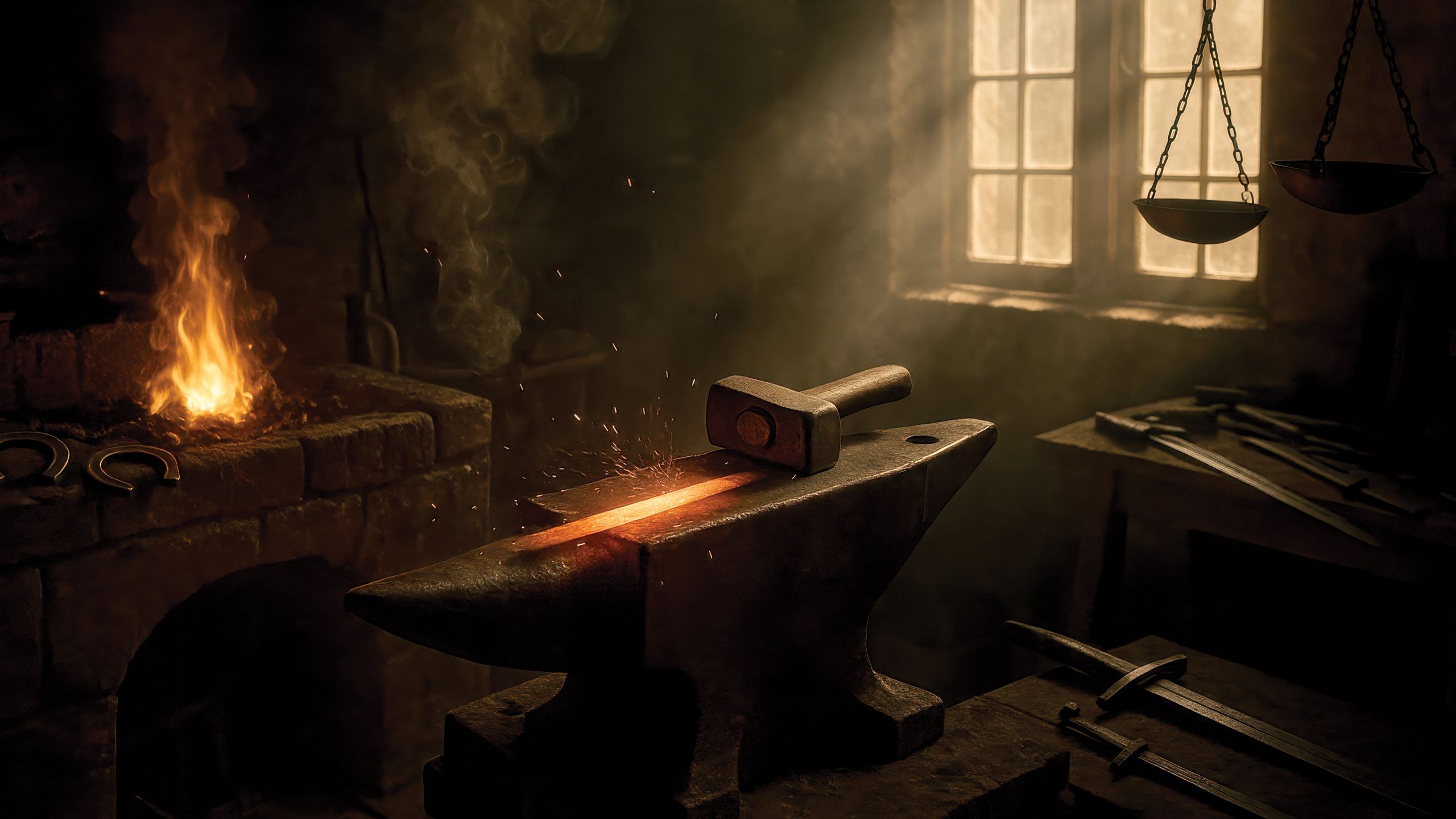Iron: A Testament to Divine Wisdom

In This Article
-
Iron as a resource of strength and utility and as a test of humanity’s ability to uphold justice. Its being “sent down” is both metaphorical, emphasizing its value as a divine provision, and literal, as modern science confirms its extraterrestrial origins.
-
Prophet David’s era indeed aligns with the historical transition from the Copper Age to the Iron Age, as supported by archaeological findings, Biblical accounts, and Divine Texts.
Throughout history, metals have held profound significance, shaping civilizations and symbolizing strength, resilience, justice, and divine provision. Sacred texts from across traditions reflect this importance, highlighting humanity’s relationship with metals like gold, silver, copper, and iron. The Old Testament, for instance, refers to iron and copper in mining and craftsmanship (e.g., Job 28:2), portraying the ingenuity of early metallurgical practices. The New Testament often uses gold and silver metaphorically, symbolizing wealth and spiritual lessons, while iron appears in the context of Roman military dominance. Similarly, the Qur’an emphasizes the significance of metals, dedicating an entire chapter—Surah Al-Hadid (Iron)—to explore the material and spiritual dimensions of iron. This chapter, “iron”ically, aligns with the atomic number of iron, which is 26. This connection is often interpreted symbolically to illustrate the Qur’an's numerical and structural harmony rather than as direct scientific evidence [1]. Can such a connection between metals and sacred texts uncover a timeless narrative of innovation, faith, and the harmonious interplay between material resources and spiritual wisdom?
A divine gift to humanity
Holy Scriptures highlight the significance of iron in several verses. In the Old Testament, the verse “A land where the rocks are iron and you can dig copper out of the hills” (Deuteronomy 8:9) offers a remarkable insight into the understanding of metals during that period. Copper is described as being "dug from ore," reflecting its extraction through mining and smelting, which was a well-established practice. In contrast, iron is referred to as "rocks," a phrasing that aligns with the historical context (3300–1200 BCE) when iron was primarily sourced from meteoric material.
Iron is referred to in the Qur’an as follows (Al-Hadid 57:25): “Assuredly, We have sent Our Messengers with manifest truths (and clear proofs of their being Messengers), and We have sent down with them the Book and the Balance so that (relations among) humankind may live by equity. And We have sent down iron, in which is stern might and benefits for humankind, so that God may mark out those who help (the cause of) God and His Messengers, though they do not see Him. Surely God is All-Strong, All-Glorious with irresistible might.”
This verse conveys a dual message: iron as a resource of strength and utility and as a test of humanity’s ability to uphold justice. Its being “sent down” is both metaphorical, emphasizing its value as a divine provision, and literal, as modern science confirms its extraterrestrial origins. Scientists affirm that iron was formed in the cores of massive stars through nuclear fusion and later distributed across the universe via supernovae explosions. These celestial events brought iron to Earth, embedding it in the planet’s crust and even delivering it through meteoric impacts. This celestial journey reflects the Qur'anic portrayal of iron as a material uniquely provided for human benefit.
The descent of iron refers to its arrival on Earth during its formation via celestial processes like meteorite impacts. This process is scientifically understood as both a one-time event during Earth's early development and an ongoing occurrence through sporadic meteorite showers. For more scientific and theological interpretations of iron's celestial origins, see the reference by Dr. Eker.
Iron's role in human civilization
Iron has been indispensable in shaping human history. Its use marked the transition from the Bronze Age to the Iron Age, revolutionizing agriculture, warfare, and infrastructure. Unlike metals like gold and silver, which are found in their native forms, iron is typically bound within ores, requiring advanced extraction techniques. This necessity reflects its value, and the ingenuity required to harness it.
The Qur'an acknowledges iron’s transformative role in civilization, particularly in the story of Dhul-Qarnayn in Surah Al-Kahf (18:96). Dhul-Qarnayn constructed an immense barrier using blocks of iron heated to glowing temperatures and bound with molten copper. This narrative highlights the sophistication of ancient metallurgical practices, which involved achieving high temperatures and carefully managing the properties of metals. The technique described mirrors the principles of modern semi-solid metalworking, where materials are heated to optimal states for shaping and bonding of dissimilar materials.
Prophet David’s mastery over iron
Another striking reference to iron in the Qur’an is found in Surah Saba (34:10): “And We made iron pliable for him.” This verse refers to Prophet David, who, by divine favor, was granted the ability to shape iron with ease. In an era when working with iron required immense effort, this gift was extraordinary. The ability to make iron pliable suggests a mastery of metallurgy far beyond the tools and techniques available at the time. It underscores both the practicality of iron and the divine facilitation granted to David in fulfilling his mission as a leader and protector. In parallel, verses in the Bible (Chronicles 22:3 and 29:2) indicate that Prophet David amassed substantial quantities of iron and other materials for the temple's construction, demonstrating his role in organizing and supplying resources.
Historically, early ironworking was limited by the rudimentary furnaces of the time, which could not reach iron’s high melting point of 1,538°C. Instead, artisans relied on heating iron to a malleable state for shaping and combining it with other metals. The Qur'anic depiction of David’s skill thus points to a profound understanding of material science and a divinely inspired ability to harness it for good.
Prophet David’s era indeed aligns with the historical transition from the Copper Age to the Iron Age, as supported by archaeological findings, Biblical accounts, and Divine Texts. The Qur’an’s emphasis on his mastery of ironworking symbolizes this shift, portraying it as a divinely guided advancement in technology and human civilization. This harmony between historical evidence and sacred texts reinforces the idea that Prophet David played a key role in bridging these two transformative ages.
Iron’s transformative properties
What sets iron apart from other metals is its remarkable property of allotropy, allowing it to exist in different crystal structures depending on temperature and pressure. This unique characteristic enables iron to undergo phase transformations that enhance its strength, ductility, and hardness. When combined with carbon, iron forms steel, a material celebrated for its unparalleled versatility and resilience. The addition of other elements like nickel, chromium, and molybdenum further refines steel’s properties, enabling its use in everything from infrastructure to aerospace technology.
The Qur'an’s emphasis on iron’s strength and utility aligns with its material role in human progress. Its capacity to be shaped, alloyed, and tailored to specific needs has made it the backbone of technological advancement. From ancient tools to modern skyscrapers, iron has continuously empowered humanity to reach new heights of innovation.
The balance between might and morality
Beyond its physical properties, the Qur'an associates iron with justice and balance. In Surah Al-Hadid (57:25), the mention of the “Book” and the “Balance” alongside iron underscores this association. The balance represents the ethical framework guiding humanity, while iron symbolizes the strength to uphold justice. Together, they form a blueprint for societal harmony.
This emphasis on balance also mirrors the technical principles governing iron and steel. In modern metallurgy, the "equilibrium diagram" is a foundational reference in iron base production. This diagram maps the relationships between variables such as carbon content and temperature, defining the equilibrium states (e.g., ferrite, pearlite, or austenite) that yield optimal material properties. By maintaining this equilibrium, metallurgists create materials with the ideal balance of strength, ductility, and hardness, essential for diverse applications.
The symbolic and technical significance of balance aligns seamlessly here. Just as the equilibrium diagram guides metallurgists in achieving structural harmony in materials, the Qur'anic emphasis on balance calls upon humanity to seek ethical equilibrium in its use of power and resources.
In conclusion, the examination of iron within sacred texts reveals a profound interplay between divine wisdom, human ingenuity, and the material world. From the Old Testament’s descriptions of early metallurgy to the Qur’an’s dedicated Surah Al-Hadid, iron is consistently presented as a divinely provided resource of immense value. This value transcends mere material utility, encompassing spiritual and ethical dimensions. The Qur’an’s emphasis on iron’s being “sent down,” now corroborated by scientific understanding of its extraterrestrial origins, underscores its unique significance. The narratives of Prophet David’s mastery over iron and Dhul-Qarnayn’s use of it in constructing a formidable barrier highlight the advanced metallurgical knowledge and divinely inspired abilities associated with this metal. Furthermore, the Qur’an’s connection of iron with justice and balance resonates with the technical principles of modern metallurgy, where achieving equilibrium is crucial for optimizing material properties. This convergence of scriptural narratives, historical evidence, and scientific understanding reinforces the idea that iron is not merely a metal but a testament to divine wisdom, a catalyst for human advancement, and a symbol of the crucial balance between might and morality.
Note
For a deeper exploration of this numerical harmony, please refer to “Numerical Codes and Gematrical Mysteries in the Qur’an,” by Toprak in The Fountain.
References
- Colacino, Alessandro. Microstructural Evolution of Iron Meteorites. Thesis, University of Naples Federico II, 2020.
- Kamil Ezgin, “Iron Oxide Nanoparticles and Surah Iron (Hadeed),” The Fountain, Issue 74, March-April 2010.
- Noah Weaver, “Metals Have Character Too!” The Fountain, Issue 113, September-October 2016.
- Nuh Gedik, “Supernova Explosion and a Miracle of The Qur'an” - The Fountain, Issue 54, April-June 2006.
- Pense, Alan W. "Iron Through the Ages." Materials Characterization, Vol. 45, 2001, pp. 1–20.
- Scott, David A. Metallography and Microstructure of Ancient and Historic Metals. Getty Conservation Institute, 1991.
- Sefik Hikmet Toprak, “Numerical Codes and Gematrical Mysteries in the Qur'an,” The Fountain, Issue 105, May-June 2015.
- Shahack-Gross, Ruth, et al. "Metalworking at Megiddo During the Late Bronze and Iron Ages." Journal of Near Eastern Studies, Vol. 76, no. 1, 2017, pp. 53–74.
- Tylecote, R. F. A History of Metallurgy. 2nd ed., Maney Publishing for the Institute of Materials, 1992.
- Vander Voort, George. Metallography of Iron-Nickel Meteorites. Vac Aero International, 2018.
- Wertime, Theodore A. "The Beginnings of Metallurgy: A New Look." Science, vol. 182, no. 4115, 1973, pp. 875–887.
- Yamauchi, Edwin. Metallurgy in the Biblical World, Department of History, Miami University, Oxford, OH 45056. Published in PSCF, Vol. 45, December 1993, pp. 252-259.
- Zeki Eker, “‘Demiri Biz İndirdik’ Mealindeki Âyetin Yorumu Üzerine,” Katre International Human Studies Journal, Issue 14, December 2022.









